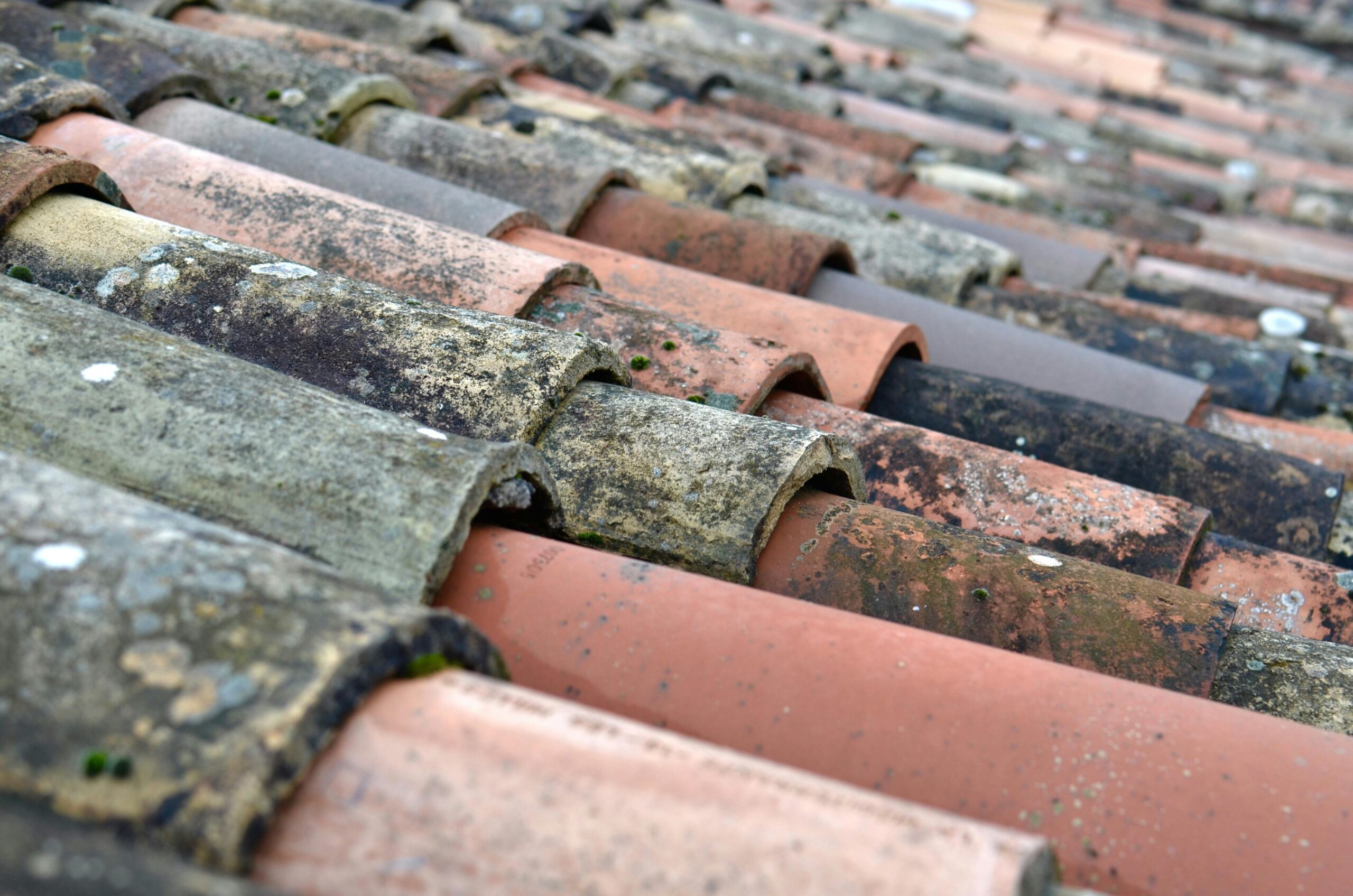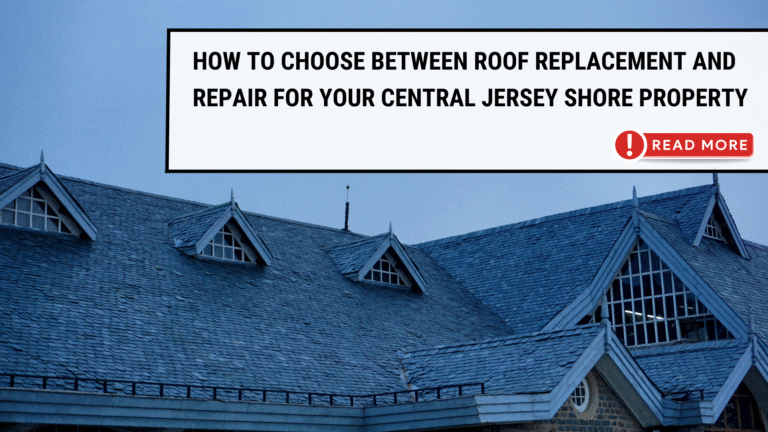- Learn how to identify whether your roof needs a simple repair or a full replacement based on age, damage, and material condition.
- Understand how coastal factors, maintenance history, and long-term value play into the financial decision.
- DSK Roofing offers Jersey Shore homeowners honest assessments, durable solutions, and expert service tailored to coastal conditions.
Owning property along the Central Jersey Shore means your roof is your first line of defense against coastal elements like salty air, UV rays, and Nor’easters. When wear shows, you face a tough decision: should you repair or replace?
Though repairs may seem budget-friendly, they can be temporary solutions that delay the inevitable. Replacing your roof is a bigger investment, so it’s crucial to determine whether it’s truly necessary.
This blog serves as your guide to making this decision with confidence. We’ll cover essential factors like weather effects, roofing materials, age, damage levels, and costs, helping you choose the best solution for your home and budget.
Understanding Your Roof’s Current Health
Before deciding between a repair and replacement, it’s essential to assess your roof’s current condition. Several core elements can influence your best course of action, especially in a high-impact area like the Central Jersey Shore.
Age of the Roof
Different roofing materials come with different lifespans. Asphalt shingles typically last 15–30 years, metal roofs can endure 40–70 years, while tile and slate roofs may surpass 50 years if roof maintenance is well done. However, in coastal climates, even durable materials degrade faster due to constant exposure. An aging roof, especially beyond 75% of its expected life, may not be worth continued repairs.
Type of Roofing Material
Materials respond differently to Jersey Shore conditions. Asphalt can dry out and crack from UV exposure. Metal may corrode more quickly due to salt-laden air. Flat roofs, common in beach homes, are vulnerable to pooling and leaks if not properly maintained.
Installation Quality
Even the best materials will fail prematurely if installed improperly. Poor flashing, uneven surfaces, or substandard ventilation can lead to chronic problems.
Previous Repairs or Patches
A history of repeated patchwork could indicate a deeper structural issue. If repairs are frequent and failing, replacement may be more cost-effective.
Weather Exposure
The Central Jersey Shore’s extreme conditions, high winds, salt spray, heavy rains, and occasional snow or ice, can accelerate wear and tear. A roof that looks fine inland might be on its last leg along the coast.
Signs You Might Need a Roof Repair
Not every roofing issue calls for a full replacement. In many cases, small problems caught early can be resolved with targeted repairs, saving you thousands and extending the life of your roof.
Visible Damage on Shingles
If you notice a few cracked, curled, or missing shingles, especially in a concentrated area, this is usually repairable. Granule loss (those tiny particles that give shingles texture) can also occur due to sun and wind exposure. If the damage is localized, a patch job can often do the trick.
Leaks or Water Stains
Stains on your ceiling or attic walls may point to a roof leak. But the source isn’t always directly above the stain; water can travel along beams and joists before it becomes visible. A professional inspection can trace and seal the entry point.
Damaged Flashing
Flashing is the thin metal sealing used around chimneys, vents, and skylights. If it becomes loose or rusted, it can allow water in. Replacing damaged flashing is a simple yet crucial repair.
Sagging or Drooping Areas
While sagging can be a red flag, minor dips may be caused by wet insulation or minor structural issues that can be corrected without replacing the entire roof.
Clogged Gutters with Granules
A buildup of shingle granules in your gutters signals aging shingles, but if it’s early in the roof’s life, spot repairs may be enough.
Small, Isolated Storm Damage
After a coastal storm, it’s not uncommon to lose a few shingles or have a branch gouge part of the roof. If the damage is minimal and contained, a timely repair can prevent further issues. The sooner you address these warning signs, the longer your roof will protect your home without needing full replacement.

Signs You Might Need a Full Roof Replacement
Sometimes, patching things up simply won’t cut it, especially when the damage is widespread or the roof has reached the end of its functional life.
Widespread Shingle Damage
If more than 25–30% of your shingles are cracked, curled, or missing, repairs may no longer be practical. Extensive surface damage weakens the roof’s ability to shed water and protect your home from the elements.
Significant Granule Loss Across the Roof
Shingles rely on a gritty coating to shield against UV rays and moisture. When you notice large bald patches or excessive granules in the gutters across multiple areas, it’s a red flag that your shingles are deteriorating.
Moss, Algae, or Fungi Growth (Extensive)
The salty, moist coastal air encourages moss and algae growth. When these organisms take hold across large portions of the roof, they trap moisture and accelerate material breakdown, especially in shaded areas.
Multiple Layers of Shingles
While layering may seem like a shortcut fix, it adds weight, traps moisture, and often voids warranties. If your roof has more than one layer, full replacement is typically the smarter (and safer) route.
Roof Sagging or Drooping (Widespread)
This indicates structural damage, often from rotted decking or compromised rafters. In these cases, the underlying structure must be addressed during replacement.
Age Beyond Lifespan
If your roof is nearing or has surpassed its expected lifespan (especially in a coastal climate), even minor issues can signal systemic failure. Replacing it ensures long-term protection and peace of mind.
High Energy Bills
An aging roof often leads to poor insulation and ventilation. If your energy bills are rising, your roof could be letting out heat in winter and drawing in heat during summer.
Advantages and Disadvantages of the Repair Option
When your roof shows signs of wear, a well-timed repair can be a smart, cost-effective solution, especially for homes along the Central Jersey Shore dealing with seasonal storms or spot damage.
Advantages
Repairs provide a cost-effective solution for localized damage, often costing much less than a full roof replacement. They typically take just a day or two, minimizing disruption. Because they target specific issues, repairs are ideal for smaller roofing concerns without extensive construction.
Disadvantages
Repairs provide temporary relief but may not resolve underlying structural issues. New shingles might not match the existing ones, leading to visible mismatches. On older roofs, repairs often don’t significantly extend lifespan, and repeated patchwork can lead to costly cycles without fixing the root problem.
Advantages and Disadvantages of the Replacement Option
When repairs are no longer enough or your roof is simply too old to perform, replacement becomes the clear path forward, especially in demanding environments like the Central Jersey Shore.
Advantages
A full roof replacement provides a long-term solution that enhances durability, curb appeal, and property value. It improves energy efficiency, reducing heating and cooling costs. Many replacements include strong warranties for added protection. It’s also a great chance to switch to durable materials like metal or architectural shingles, ideal for the harsh Jersey Shore climate.
Disadvantages
A roof replacement is a wise long-term investment, but it has a higher upfront cost than repairs. The process can be disruptive, taking several days and involving noise and mess. Even with professionals, some debris and dust will require cleanup afterward.
Let’s Break Down the Numbers
When deciding between a roof repair and full replacement, understanding the financial implications can help you make a more informed choice.
Repair Costs
Roof repair costs can vary widely depending on the extent of the damage, the type of roofing material, and the accessibility of the problem area. Small fixes might run a few hundred dollars, but if multiple areas need attention or the materials are costly, the bill can quickly climb. If repair estimates approach 30–50% of the cost of a full replacement, it may be wiser to invest in a new roof.
Replacement Costs
Roof replacement involves several variables: roof size and pitch, material selection, tear-off of the old roof, decking repairs, and local permits. For Central Jersey Shore homes, upgrades to more durable, coastal-resistant materials can increase the price but also offer better protection and longevity.
ROI (Return on Investment)
A new roof can significantly boost your home’s value, often recouping up to 60–70% of the investment when selling.
The Role of Professional Roof Inspection
Before committing to a repair or replacement, a professional roof inspection is essential. A trained expert can spot issues that go far beyond surface damage, like problems in the attic, deteriorating decking, or poor ventilation that may not be visible from the outside. Always request a written report and get multiple quotes to compare scope, materials, and pricing. This helps you make a well-informed, cost-effective decision backed by facts, not guesswork.
Tips to Extend Roof Life
With the Central Jersey Shore’s challenging coastal environment, proactive care can significantly extend the life of your roofing system.
Regular Inspections
Perform DIY visual checks seasonally, especially after storms, but don’t skip professional inspections once or twice a year. Pros can detect early signs of damage that are easy to miss from the ground.
Gutter Cleaning
Clogged gutters can cause water to back up under shingles, leading to leaks and rot. Clean them regularly, especially during fall and after storms.
Tree Trimming
Overhanging branches can scrape shingles or break off during wind gusts. Keep trees trimmed to reduce impact and debris buildup.
Debris Removal
Leaves, twigs, and other storm debris can trap moisture on your roof. Clear them promptly to prevent mold and deterioration.
Addressing Moss/Algae
If you spot green patches, use gentle, non-damaging cleaning methods to remove growth before it spreads and damages shingles.
Ventilation Checks
Ensure your attic is properly ventilated. Good airflow prevents heat and moisture buildup, which can warp decking and shorten shingle life.
Routine roof maintenance is not just upkeep; it’s a long-term cost saver. Consistency here means fewer emergency repairs and a much longer-lasting roof.
When protecting your Central Jersey Shore home, deciding between a roof repair and full replacement is important. Given the harsh coastal conditions, expert guidance is essential. At DSK Roofing, we combine local knowledge, top-tier materials, and honest advice to help you make the right choice for your property. Contact us today for a free quote!

